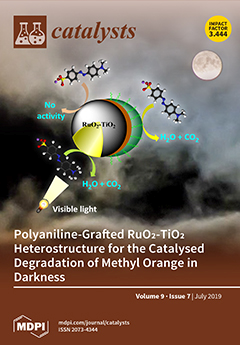Unlike many other water disinfection methods, hydroxyl radicals (HO
•) produced by the Fenton reaction (Fe
2+/H
2O
2) can inactivate pathogens regardless of taxonomic identity of genetic potential and do not generate halogenated disinfection by-products. Hydrogen peroxide (H
[...] Read more.
Unlike many other water disinfection methods, hydroxyl radicals (HO
•) produced by the Fenton reaction (Fe
2+/H
2O
2) can inactivate pathogens regardless of taxonomic identity of genetic potential and do not generate halogenated disinfection by-products. Hydrogen peroxide (H
2O
2) required for the process is typically electrogenerated using various carbonaceous materials as cathodes. However, high costs and necessary modifications to the cathodes still present a challenge to large-scale implementation. In this work, we use granular activated carbon (GAC) as a cathode to generate H
2O
2 for water disinfection through the electro-Fenton process. GAC is a low-cost amorphous carbon with abundant oxygen- and carbon-containing groups that are favored for oxygen reduction into H
2O
2. Results indicate that H
2O
2 production at the GAC cathode is higher with more GAC, lower pH, and smaller reactor volume. Through the addition of iron ions, the electrogenerated H
2O
2 is transformed into HO
• that efficiently inactivated model pathogen (
Escherichia coli) under various water chemistry conditions. Chick–Watson modeling results further showed the strong lethality of produced HO
• from the electro-Fenton process. This inactivation coupled with high H
2O
2 yield, excellent reusability, and relatively low cost of GAC proves that GAC is a promising cathodic material for large-scale water disinfection.
Full article





